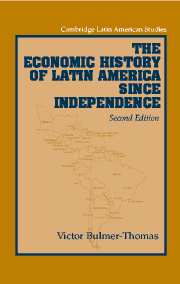Book contents
- Frontmatter
- Contents
- List of tables, figures, and maps
- Preface to the second edition
- Preface
- List of abbreviations
- 1 Latin American economic development: an overview
- 2 The struggle for national identity from independence to midcentury
- 3 The export sector and the world economy, circa 1850–1914
- 4 Export-led growth: the supply side
- 5 Export-led growth and the nonexport economy
- 6 The First World War and its aftermath
- 7 Policy, performance, and structural change in the 1930s
- 8 War and the new international economic order
- 9 Inward-looking development in the postwar period
- 10 New trade strategies and debt-led growth
- 11 Debt, adjustment, and the shift to a new paradigm
- 12 Conclusions
- Appendix 1 Data sources for population and exports before 1914
- Appendix 2 The ratio of exports to gross domestic product, the purchasing power of exports, and the volume of exports, circa 1850 to circa 1912
- Appendix 3 Gross domestic product per head, 1913, 1928, 1980, and 2000
- Bibliography
- Index
- CAMBRIDGE LATIN AMERICAN STUDIES
8 - War and the new international economic order
Published online by Cambridge University Press: 05 June 2012
- Frontmatter
- Contents
- List of tables, figures, and maps
- Preface to the second edition
- Preface
- List of abbreviations
- 1 Latin American economic development: an overview
- 2 The struggle for national identity from independence to midcentury
- 3 The export sector and the world economy, circa 1850–1914
- 4 Export-led growth: the supply side
- 5 Export-led growth and the nonexport economy
- 6 The First World War and its aftermath
- 7 Policy, performance, and structural change in the 1930s
- 8 War and the new international economic order
- 9 Inward-looking development in the postwar period
- 10 New trade strategies and debt-led growth
- 11 Debt, adjustment, and the shift to a new paradigm
- 12 Conclusions
- Appendix 1 Data sources for population and exports before 1914
- Appendix 2 The ratio of exports to gross domestic product, the purchasing power of exports, and the volume of exports, circa 1850 to circa 1912
- Appendix 3 Gross domestic product per head, 1913, 1928, 1980, and 2000
- Bibliography
- Index
- CAMBRIDGE LATIN AMERICAN STUDIES
Summary
The Second World War, which began in Europe in September 1939, was the third major external shock to strike Latin America in twenty-five years. Despite many similarities with the impact of the First World War and some with the 1929 Depression, the implications of the Second World War for Latin America were quantitatively and qualitatively different from the earlier shocks.
First, the war was far more devastating for Latin America in terms of disruption to its traditional markets. By 1940 the Axis powers controlled much of the European coastline from northern Norway to the Mediterranean Sea, and the consequent British blockade deprived the Latin American republics, despite their initial neutrality in the war, of access to continental European markets. Furthermore, the British market – so important for Argentina and Uruguay – started to shrink as the United Kingdom retreated into a war economy in which only the most essential imports were permitted.
Second, the war erupted after nearly a decade of growing disillusionment with the traditional export-led model in Latin America. World trade in the 1930s had recovered, but it was increasingly “managed,” often bilateral, and heavily distorted by higher tariffs and a plethora of nontariff barriers. The great powers had frequently acted irresponsibly (e.g., the Smoot–Hawley tariff) or selfishly (e.g., the Roca–Runciman pact). The result was a growing sense of nationalism in a number of Latin American republics and a greater commitment – albeit poorly articulated – to inward-looking development and industrialization as an alternative model to traditional export-led growth.
- Type
- Chapter
- Information
- The Economic History of Latin America since Independence , pp. 232 - 267Publisher: Cambridge University PressPrint publication year: 2003

